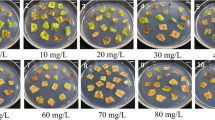Abstract
Transgenic cotton plants were developed by pistil drip inoculation in a solution containing Agrobacterium carrying a gene for resistance to the herbicide Basta (bar), 10% (w/v) sucrose, 0.05% (v/v) Silwet L-77 and 40 mg acetosyringone l−1. Pistil drip during 17:00–19:00 on the first day of flowering resulted in 0.07–0.17% Basta-resistant plants/number of viable seeds generated, and stigma excision prior to pistil drip during this time period gave rise to a transformation efficiency of 0.46–0.93%, in contrast with 0.04–0.06% generated from pistil drip during 9:00–11:00 on the second day of flowering. PCR and Southern blot analysis confirmed the integration of the bar gene into the cotton genome, and a T1 and T2 generation herbicide resistance test consistently revealed expression and stable heritability of the bar gene in the two generations.




Similar content being viewed by others
References
Bechtold N, Jaudeau B, Jolivet S et al (2000) The maternal chromosome set is the target of the T-DNA in the in planta transformation of Arabidopsis thaliana. Genetics 155:1875–1887
Bechtold N, Jolivet S, Voisin R et al (2003) The endosperm and the embryo of Arabidopsis thaliana are independently transformed through infiltration by Agrobacterium tumefaciens. Transgenic Res 12:509–517
Bent A (2000) Arabidopsis in planta transformation. Uses, mechanisms, and prospects for transformation of other species. Plant Physiol 124:1540–1547
Bhat SR, Srinivasan S (2002) Molecular and genetic analyses of transgenic plants: Considerations and approaches. Plant Sci 163:673–681
Desfeux C, Clough S, Bent A (2000) Female reproductive tissues are the primary target of Agrobacterium-mediated transformation by the Arabidopsis floral-dip method. Plant Physiol 123:895–904
Firoozabady E, DeBoer D (1993) Plant regeneration via somatic embryogenesis in many cultivars of cotton (Gossypium hirsutum L.). In Vitro Cell Dev Biol Plant 29:166–173
Jensen WA, Fisher DB (1967) Cotton embryogenesis: the entrance and discharge of the pollen tube in the embryo sac. Planta 78:158–183
Langridge P, Brettschneider R, Lazzeri P et al (1992) Transformation of cereals via Agrobacterium and the pollen pathway: a critical assessment. Plant J 2:631–638
Sunilkumar G, Rathore KS (2001) Transgenic cotton: factors influencing Agrobacterium-mediated transformation and regeneration. Mol Breed 8:37–52
Tjokrokusumo D, Heinrich T, Wylie S et al (2000) Vacuum infiltration of Petunia hybrida pollen with Agrobacterium tumefaciens to achieve plant transformation. Plant Cell Rep 19:792–797
Trolinder NL, Xhixian C (1989) Genotype specificity of the somatic embryogenesis response in cotton. Plant Cell Rep 8:133–136
Wang Y, Chen D, Wang D et al (2004) Over-expression of Gastrodia anti-fungal protein enhances Verticillium wilt resistance in coloured cotton. Plant Breed 123:454–459
Wilkins TA, Rajasekaran K, Anderson DM (2000) Cotton biotechnology. Crit Rev Plant Sci 19:511–550
Wilkins T, Mishra R, Trolinder N (2004) Agrobacterium-mediated transformation and regeneration of cotton. J Food Agric Environ 2:179–187
Wu K, Lu Y, Feng H et al (2008) Suppression of cotton bollworm in multiple crops in China in areas with Bt toxin-containing cotton. Science 321:1676–1678
Ye G, Stone D, Pang S et al (1999) Arabidopsis ovule is the target for Agrobacterium in planta vacuum infiltration transformation. Plant J 19:249–257
Zhou G, Weng J, Zeng Y et al (1983) Introduction of exogenous DNA into cotton embryos. Methods Enzymol 101:433–481
Acknowledgements
The authors specially thank Dr. Muhammad Saeed for a critical review of the manuscript. This work was supported by National High Technology Research and Development Program of China (Grant No. 2006AA100105), Science & Technology Pillar Program of Jiangsu Province (Grant No. BE2008310) and Programme of Introducing Talents of Discipline to Universities (Grant No. B08025).
Author information
Authors and Affiliations
Corresponding author
Rights and permissions
About this article
Cite this article
TianZi, C., ShenJie, W., Jun, Z. et al. Pistil drip following pollination: a simple in planta Agrobacterium-mediated transformation in cotton. Biotechnol Lett 32, 547–555 (2010). https://doi.org/10.1007/s10529-009-0179-y
Received:
Revised:
Accepted:
Published:
Issue Date:
DOI: https://doi.org/10.1007/s10529-009-0179-y




